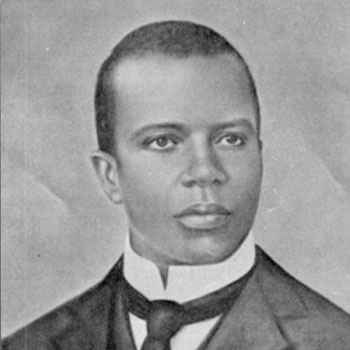Early years
Scott Joplin was born in 1868 to Giles Joplin, and Florence Givens. By 1880, the Joplins moved to Texarkana, Arkansas where Giles worked as a railroad laborer and Florence as a maid. Joplin was given a rudimentary musical education by his family. According to a family friend, the young Joplin was serious and ambitious studying music and playing the piano after school. While a few local teachers aided him, he received most of his musical education from Julius Weiss, a German-born American Jewish music professor.
Chicago World's Fair
In the late 1880s, having performed at various local events as a teenager, Joplin gave up his job as a railroad laborer and left Texarkana to become a traveling musician. Churches and brothels were among the few options for steady work. Joplin played pre-ragtime "jig-piano" in various red-light districts throughout the mid-South, and some claim he was in Sedalia and St. Louis, Missouri, during this time. In 1893, while in Chicago for the World's Fair, Joplin formed a band in which he played cornet and also arranged the band's music. Although the World's Fair minimized the involvement of African-Americans, black performers still came to the saloons, cafés and brothels that lined the fair.
Life in Missouri
In 1894, Joplin arrived in Sedalia, Missouri. He performed in the Queen City Cornet Band and his own six-piece dance orchestra. Two businessmen from New York published Joplin's first two works, the songs "Please Say You Will" and "A Picture of Her Face", in 1895. Joplin's visit to Temple, Texas enabled him to have three pieces published there in 1896, including the "Great Crush Collision March”.
Maple Leaf Rag
Scott Joplin signed a contract on August 10, 1899 with John Stillwell Stark, to publish Maple Leaf Rag. The contract stipulated that Joplin would receive a 1% royalty on all sales of the Maple Leaf Rag, with a minimum sales price of 25 cents. With the inscription "To the Maple Leaf Club" prominently visible along the top of at least some editions, it is likely that the rag was named after the Maple Leaf Club. The "Maple Leaf Rag" did serve as a model for the hundreds of rags to come from future composers, especially in the development of classic ragtime. After the publication of the "Maple Leaf Rag", Joplin was soon being described as "King of rag time writers".
Personal Life
After Scott Joplin and his wife Belle moved to St. Louis in early 1900, they had a baby daughter who died only a few months after birth. Joplin's relationship with his wife was difficult, as she had no interest in music. They eventually separated and then divorced. In June 1904, Joplin married Freddie Alexander of Little Rock, Arkansas. She died on September 10, 1904, of complications resulting from a cold, ten weeks after their wedding.
Joplin’s Opera Company
In the early 1900’s, Joplin created an opera company of 30 people and produced his first opera A Guest of Honor for a national tour. It is not certain how many productions were staged, or even if this was an all-black show or a racially mixed production. Joplin could not meet the company's payroll or pay for its lodgings at a theatrical boarding house. It is believed that the score for A Guest of Honor was lost and perhaps destroyed because of non-payment of the company's boarding house bill.
Failure of Treemonisha
In 1907, Joplin moved to New York City, which he believed was the best place to find a producer for a new opera. After his move to New York, Joplin met Lottie Stokes, whom he married in 1909. In 1911, unable to find a publisher, Joplin undertook the financial burden of self publishing his opera called Treemonisha. In 1915, he invited a small audience to hear it at a rehearsal hall in Harlem. It was "a miserable failure" to a public not ready for "crude" black musical forms—so different from the European grand opera of that time. The audience, including potential backers, walked out.
Later years and Death
By 1916, Joplin was suffering from neurosyphilis. In January 1917, he was admitted to Manhattan State Hospital. He died there on April 1 of syphilitic dementia at the age of 48 and was buried in a pauper's grave that remained unmarked for 57 years. His grave at St. Michael's Cemetery in East Elmhurst was finally given a marker in 1974, the year The Sting, which showcased his music, won for Best Picture at the Oscars.
